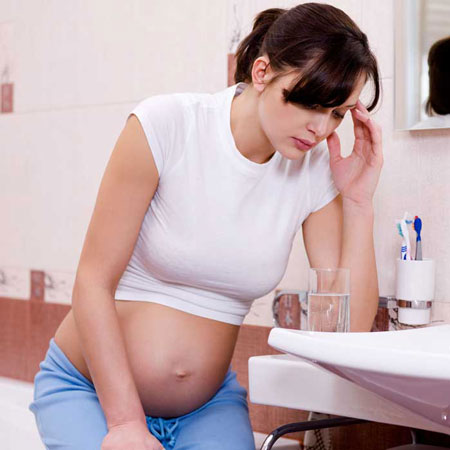 Hyperemisis Gravidarum HG is characterised by persistent vomiting and severe nausea. The woman suffering from HG is unable to maintain adequate hydration and fluid, which will jeopardise her electrolyte and nutritional status. Dehydration, ketonuria, electrolyte imbalance and a body weight loss of greater than 5% of pre-pregnancy weight characterise HG. Onset is always in the first trimester, usually 6 to 8 weeks, and tends to re-occur with subsequent pregnancies. HG occurs in around 1:100 pregnancies.
Hyperemisis Gravidarum HG is characterised by persistent vomiting and severe nausea. The woman suffering from HG is unable to maintain adequate hydration and fluid, which will jeopardise her electrolyte and nutritional status. Dehydration, ketonuria, electrolyte imbalance and a body weight loss of greater than 5% of pre-pregnancy weight characterise HG. Onset is always in the first trimester, usually 6 to 8 weeks, and tends to re-occur with subsequent pregnancies. HG occurs in around 1:100 pregnancies.
HG is associated with raised thyroxine levels or suppressed TSH levels and HCG. Helicobacter pylori eradication has been reported as resolving intractable NVP. Once again there is no good evidence to support psychological and behavioural theories with HG.
There are several serious complications that can result from HG. These include:
- Wernicke’s encephalopathy caused by thiamine deficiency (characterised by diplopia, abnormal ocular movements, ataxia and confusion)
- Hyponatraemia
- Mallory-Weiss tears of the oesophagus leading to haematemesis
- Psychological problems
- Low fetal birth weight (severe HG)
- Fetal death (Wernicke’s encephalopathy, associated with a 40% fetal death rate)
Management of Hyperemesis Gravidarum
If outpatient management is not effective for women suffering from HG then they may warrant hospitalisation. Intravenous fluid and electrolyte replacement, thiamine supplementation (Vitamin B1), use of conventional antiemetics and psychological support are the mainstays of management.
Assessment:
1. History taking:
- Present obstetric history
- Previous obstetric history (the previous history makes diagnosis more likely)
- Previous medical history
2. Physical assessment:
- Signs of dehydration: ketosis, postural hypotension and tachycardia
- Weight to determine weight loss
3. Investigations:
- They may perform an ultrasound scan to confirm gestational age, diagnose multiple pregnancies, and exclude hydatidiform mole
- Full blood count (haematocrit raised), electrolytes (hyponatraemia, hypokalaemia), thyroid function test (thyrotoxicosis with raised free thyroxine levels and/or suppressed TSH levels), LFT (raised transaminase levels but below 200U, mild elevation in serum amylase levels)
- Urinalysis (ketones, specific gravity usually raised)
- Maternal weight
Treatment:
If the woman is ketotic and unable to maintain hydration then they admitted her to the hospital. You should consider fluid and electrolyte replacement with Normal Saline or Hartmans with potassium chloride added.
CAUTION: Do not use dextrose-containing fluid as this can precipitate Wernicke’s encephalopathy and will not correct hyponatraemia. Do not use double-strength saline as can lead to central pontine myelinolysis.
Pharmacological therapies:
- If vomiting fails to respond to IV fluids and electrolytes alone then they should offer pharmacological therapies.
- Antihistamines: a doxylamine/pyridoxine combination should be the standard of care as it has the greatest evidence to support it. Unfortunately, Australia cannot obtain this exact combination. They should consider H1 receptor antagonists (dimenhydrinate, diphenhydramine and hydroxyzine) in the management of NVP.
- Vitamins: they may consider pyridoxine and vitamin B6 monotherapy supplementation
- Dopamine antagonists: phenothiazines (eg. chlorpromazine, promethazine) are safe and effective for severe NVP. Metoclopramide is safe to use for NVP though there is limited evidence of efficacy
- Coticosteroids: Women should avoid this during the 1st trimester because of the possible increased risk of oral clefting. It should be restricted to refractory cases.
- Esophageal reflux therapies such as antacids and H2 receptor antagonists (ranatidine) can be used as they have been shown to bring symptomatic relief
- Extensive data exist to show a lack of teratogenesis with dopamine antagonists (metoclopramide and domperidone), phenothiazines (chlorpromazine and prochloperazine) and histamine H1 receptor blockers (promethazine and cyclizine)
- Promethazine is the most frequently prescribed medication for nausea and vomiting in Australia
Psychological support
- All women with HG require emotional support
- Psychotherapy, hypnotherapy and behavioural therapy can contribute to the treatment of HG
References
- Godet PF, Marie-Cardine M. Neuroleptics, schizophrenic and pregnancy. Epidemiological and teratologic study. Encephalc 1991: 17: 543-7
- Iancu T. Kotler M. Spivak B, et al. Psychiatric aspects of hyperemesis gravidarum. Psychother Psychosom 1994; 61: 143-9
- Kocak I, Akcan Y, Ustun C, Demirel C, Cengiz L, Yanuk FF. Helicobacter pylori seropositivity in patients with hyperemesis gravidarum. Int J Gynecol Obstet 1999;66:251-4
- Milkovich L, Van Den Berg BJ. An evaluation of the teratogenicity of certain antinauseant drugs. Am J Obstet Gynecol 1976; 125: 244-8
- Nelson-Piercy C. Treatment of nausea and vomiting in pregnancy: When should it be treated and what can be safely taken? Drug Safety 1998; 2: 155-64
- Scro A, Einarson T, Koren G. Pregnancy outcome following first trimester exposure to antihistamines-meta analysis. Am J Perinatol 1997: 14: 119-24


Recent Comments